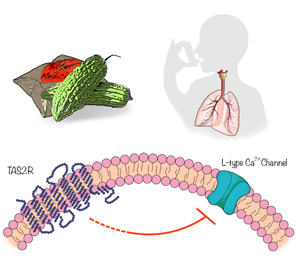 That kale and bitter melon you are eating may someday save your life. An interdisciplinary team of scientists at UMass Medical School has taken a step forward in understanding how the substances that give some foods their bitter flavor also act to reverse the contraction of airway cells, a process known as bronchodilation. This effect may one day be harnessed to provide improved treatments for airway obstructive diseases such as asthma and chronic obstructive pulmonary disease. The findings were published Tuesday, March 5, in the open access journal PLOS Biology.
That kale and bitter melon you are eating may someday save your life. An interdisciplinary team of scientists at UMass Medical School has taken a step forward in understanding how the substances that give some foods their bitter flavor also act to reverse the contraction of airway cells, a process known as bronchodilation. This effect may one day be harnessed to provide improved treatments for airway obstructive diseases such as asthma and chronic obstructive pulmonary disease. The findings were published Tuesday, March 5, in the open access journal PLOS Biology.
“I am excited that someday, with more research, there may be a new class of bronchodilators which are able to reverse an asthma attack quicker and with fewer side effects than is currently available to patients,” said Ronghua ZhuGe, PhD, associate professor of microbiology and physiological systems and senior author of the study.
The sense of taste is mediated by taste receptor cells bundled in our taste buds. Most humans experience five types of tastes: sweet, salty, sour, bitter and savory. Bitter taste receptors most likely evolved to help alert the body to potentially harmful foods that have spoiled or are toxic. The receptors have long been thought to only exist in certain cells present in the tongue. Over the last few years, however, scientists have come to realize that these receptors are present in many other cells throughout the body. Specifically, bitter taste receptors on smooth muscle cells in the airway act to relax the cells when exposed to bitter-tasting substances.
A hallmark of an asthma attack is excessive contraction of smooth muscle cells, which causes narrowing of the airways and subsequent breathing difficulties. The fact that bitter substances can relax these smooth muscle cells suggests that they may have the potential to halt asthma attacks and in fact could even be an improvement over current treatments since the relaxation effects are quite fast. Indeed, experiments in mice suggest that the effects are stronger.
However, the mechanisms by which bitter taste receptor activation causes a cell to relax were unknown. To help unravel these mechanisms, Dr. ZhuGe and colleagues examined the effect of bitter substances on the contraction of airways and in single isolated cells.
During an asthma attack, channels on the membrane of smooth muscle cells in the airways open. This allows calcium to flow into the cell, causing it to contract. When the cells contract, the airway becomes narrower and makes breathing more difficult. Dr. ZhuGe and colleagues determined that bitter substances act by shutting down these calcium channels, allowing bronchodilation.
Bitter taste receptors, like most receptors, span the plasma membrane of the cell. Part of the receptor is outside the cell, able to bind (and hence “sense”) bitter substances outside the cell. When a bitter compound binds to a bitter taste receptor, the receptor releases a G-protein, which then splits into two parts: a G alpha subunit and G beta-gamma dimer. “It is the G beta-gamma dimer that likely acts to close the calcium channels on the plasma membrane,” said Kevin Fogarty, MS, research assistant professor of molecular medicine and microbiology & physiological systems and director of the Biomedical Imaging Group in the Program in Molecular Medicine, and a co-author of the study. “Once the channels are closed, the calcium level returns to normal and the cell relaxes,” he said. “This ends the asthma attack.”
“With this new understanding of how bitter substances are able to relax airways, we can focus our attention on studying these receptors and on finding even more potent bitter compounds with the potential to be used therapeutically to end asthma attacks,” said ZhuGe.